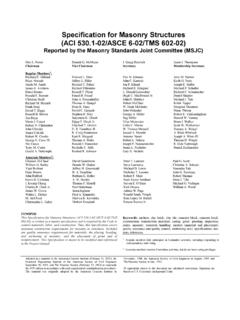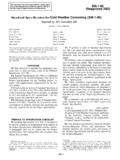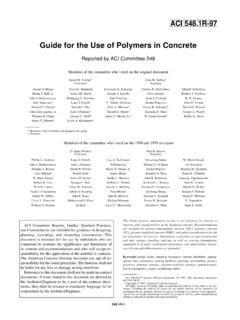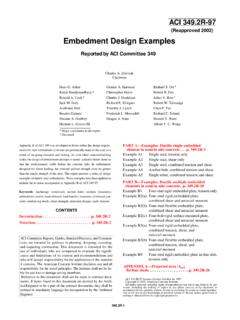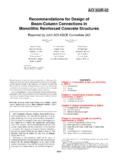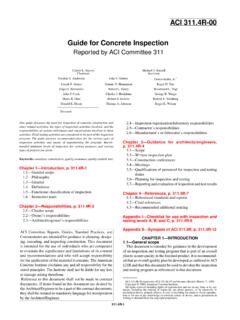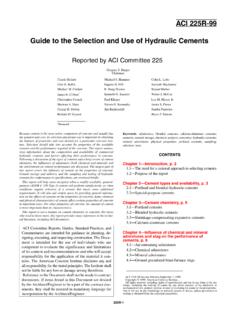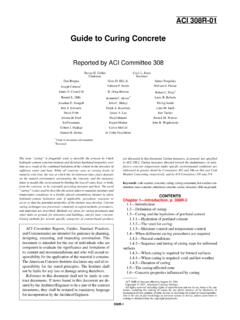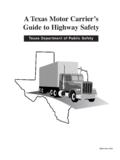Transcription of 313-97 Standard Practice for Design and …
1 ACI 313-97 was adopted as a Standard of the American Concrete Institute onJanuary 7, 1997, to supersede ACI 313-91, in accordance with the Institute s stan-dardization procedure. Copyright 1998, American Concrete rights reserved including rights of reproduction and use in any form or by anymeans, including the making of copies by any photo process, or by electronic ormechanical device, printed, written, or oral, or recording for sound or visual repro-duction or for use in any knowledge or retrieval system or device, unless permis-sion in writing is obtained from the copyright proprietors. This Standard was submitted to letter ballot of the commit-tee and was approved in accordance with Institute stan-dardization ACI Standard Practice gives material, Design , and constructionrequirements for concrete silos, stave silos, and stacking tubes for storinggranular materials.
2 It includes Design and construction recommendations forcast-in-place or precast and conventionally reinforced or post-tensioned and stacking tubes are special structures, posing special problemsnot encountered in normal building Design . While this Standard refers toBuilding Code Requirements for Structural Concrete (ACI 318) for manyrequirements, it puts forth special requirements for the unique cases of staticand dynamic loading from funnel flow, mass flow, concentric flow, and asym-metric flow in silos, and the special loadings on stacking tubes. The standardincludes requirements for seismic Design and hopper bottom words: asymmetric flow; bins; circumferential bending; concrete;concrete construction; dead loads; dynamic loads: earthquake resistantstructures; formwork (construction); funnel flow; granular materials; hop-pers; jumpforms; lateral loads: loads (forces); lowering tubes; mass flow;ov erpressure; quality control; reinforced concrete; reinforcing steels; silos;slipform construction; stacking tubes; stave silos; stresses; structural anal-ysis; structural Design ; thermal stresses; 1 General, p.
3 Drawings, specifications, and calculationsChapter 2 Materials, p. Precast concrete Tests of materialsChapter 3 Construction requirements, p. Concrete Sampling and testing Details and placement of Concrete placing and Concrete protection and Lining and coatingStandard Practice for Design and Construction of Concrete Silos and Stacking Tubes for Storing Granular Materials (ACI 313-97 )ACI 313-97 Mostafa H. MahmoudChairmanVahe A. AprahamianDonald MidgleyWilliam D. ArockiasamyGerman R. GurfinkelJack MollLeon BialkowskiErnest C. HarrisLee A. NashAlfred G. BisharaDonald S. JackRodney M. NohrWilliam H. BokhovenRichard T.
4 JenkynJ. Michael RotterWilliam L. ClarkMichael E. JohnsonJohn E. SadlerJames M. EbmeierRobert D. JohnsonSargis S. SafarianStephen G. FrankoskyF. Thomas JohnstonJoseph R. TuckerReported by ACI Committee 313313-2 ACI Tolerances for slipformed and jumpformed structuresChapter 4 Design , p. Details and placement of Wall Hopper Column Foundation designChapter 5 Concrete stave industrial silos, p. Erection Wall Hoops for stave Concrete stave testingChapter 6 Post-tensioned concrete silos, p. Post-tensioning Tendon Bonded Unbonded Post-tensioning Wrapped Details and placement of non-prestressed Wall Stressing Vertical bending moment and shear due to TolerancesChapter 7 Stacking tubes, p.
5 General Load Tube wall Foundation or reclaim tunnelChapter 8 Specified and recommended references, p. 313-17 Appendix A Notation, p. 313-18 CHAPTER 1 IntroductionThis document, which covers Design and construction ofconcrete silos and stacking tubes for storing granular materi-als, replaced the 1968 ACI Committee 313 Report 65-37 andwas adopted as an ACI Standard in March 1977 as ACI was subsequently revised in 1983 and 1991. The currentrevision reflects the most recent state-of-the-art in structuraldesign, detail, and construction of concrete silos and stack-ing pressures are exerted by the stored material at restand shall be computed by methods presented.
6 Flow pressuresthat differ from static pressures are exerted by the stored ma-terial during flow and also shall be computed by the of the structures shall consider both static and sections of ACI 318 shall DefinitionsThe term silo, as used herein, applies to any upright con-tainer for storing bulk granular names such as bins and bunkers are used indifferent localities, but for purposes of this Standard , all suchstructures are considered to be silos. Stacking tubes or lowering tubes are relatively slender,free-standing, tubular concrete structures used to stack conicalpiles of granular materials. See Commentary Section Slipformed silos are constructed using a typically 4 ft.
7 ( m) high continuously moving form. Jumpformed silos are constructed using three typically4 ft. ( m) high fixed forms. The bottom lift is jumped tothe top position after the concrete hardens hopper is the sloping, walled portion at the bottom ofa silo. Stave silos are silos assembled from small precast con-crete units called staves, usually tongued and grooved, andheld together by exterior adjustable steel special terms are defined in the ScopeThis Standard covers the Design and construction of con-crete silos and stacking tubes for storing granular for storing of ensilage have different requirements andare not included. However, industrial stave silos for storageof granular materials are of precast concrete is limited to that for industri-al stave Standard is based on the strength Design method.
8 Pro-visions for the effect of hot stored material are included. Ex-planations of requirements of the Standard , additional designinformation, and typical details are found in the Drawings, specifications, and Project drawings and project specifications for silosshall be prepared under the direct supervision of and bear theseal of the Project drawings and project specifications shallshow all features of the work, naming the stored materials as-sumed in the Design and stating their properties, and includ-ing the size and position of all structural components,connections and reinforcing steel, the required concretestrength, and the required strength or grade of reinforcingand structural AND CONSTRUCTION OF CONCRETE SILOS AND STACKING TUBES CHAPTER 2 GeneralAll materials and tests of materials shall conform to ACI301, except as otherwise CementsCement shall conform to ASTM C 150 (Types I, IA, II,IIAA, III and IIIA), ASTM C 595 (excluding Types S, SA,IS and IS-A)
9 , or ASTM C AggregatesThe nominal maximum size of aggregate for slipformedconcrete shall not be larger than one-eighth of the narrowestdimension between sides of wall forms, nor larger thanthree-eighths of the minimum clear spacing between individ-ual reinforcing bars or vertical bundles of WaterWater for concrete shall be potable, free from injuriousamounts of substances that may be harmful to concrete orsteel. Non-potable water may be used only if it producesmortar cubes, prepared according to ASTM C 109, having 7-and 28-day strengths equal to at least the strength of similarspecimens made with potable Air-entraining, water reducing, retarding or acceler-ating admixtures that may be required for specific construc-tion conditions shall be submitted to the engineer forapproval prior to their Hoop post-tensioning rods shall be hot-dip galva-nized or otherwise protected from corrosion.
10 Connectors,nuts and lugs shall either be hot-dip galvanized or made fromcorrosion-resistant castings or corrosion-resistant steel. Gal-vanizing shall conform to ASTM A Malleable iron castings shall conform to ASTM A Precast concrete Materials for staves manufactured by the dry-packvibratory method shall conform to ASTM C Before a stave is used in a silo, drying shrinkage shallhave caused the stave to come within 90 percent of its equi-librium weight and length as defined by ASTM C Tests of Tests of materials used in concrete construction shallbe made as required by the applicable building codes and theengineer. All material tests shall be by an agency acceptableto the Tests of materials shall be made in accordance withthe applicable ASTM standards.
